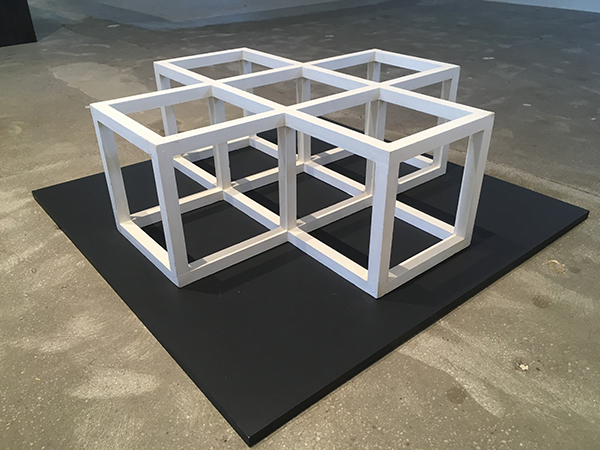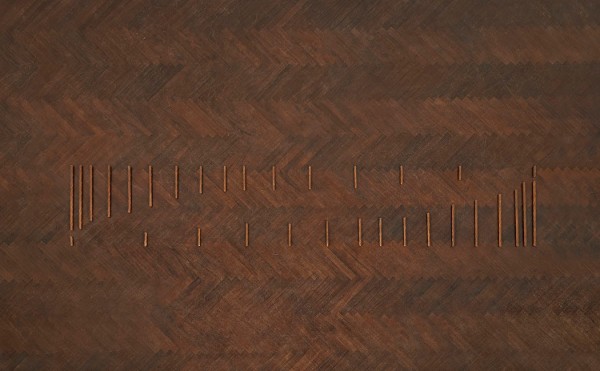Auctions
The Skinny: Three Minimalist Works by LeWitt, Judd, and Andre
The Donald Judd work comes from the collection of the artist's son.

The Donald Judd work comes from the collection of the artist's son.

The Skinny is a series that explores artworks of note currently offered on artnet Auctions.
Works by Donald Judd, Sol LeWitt, and Carl Andre—exemplars of the Minimalist movement—are currently on offer at “Minimalism: Concept/Object” our sale at artnet Auctions, which runs through June 9.
In the mid 1960s, LeWitt had exhibited with Park Place Gallery Group and then with Paula Cooper Gallery, which shared many notable patrons including Vera List. The first exhibition at Paula Cooper was a benefit for the Student Mobilization Committee to End the War in Vietnam, which included work by Andre, Flavin, Judd, LeWitt and Robert Mangold.
By the end of the decade, LeWitt and Andre fell into the fold at the West Coast gallery of Virginia Dwan. At the close of the gallery, much of Dwan’s inventory was passed to director John Weber who spent much time traveling through Europe to advance these artists’ careers, before opening a gallery of his own in New York located at 420 West Broadway, which was known as the first gallery building in Soho.
Judd (much like Flavin) began his exhibitions with more established dealers including Richard Bellamy, who was at the forefront of the American Avant Garde in New York in the early 60s New York, as well as Leo Castelli, and Irving Blum, the former director of LA’s famed Ferus Gallery.
Among other artworks in the sale, including those of James Turrell, Ellsworth Kelly, and Agnes Martin (whose work recently set a new record at auction), here’s the skinny on three artworks that exemplify Minimalist themes.

Carl Andre, 32 Part Reciprocal Invention (1971). Courtesy Mnuchin Gallery.
What
Carl Andre, 32 Part Reciprocal Invention (1971)
Origin story
This work was originally exhibited at Galerie Konrad Fischer, Dusseldorf in1972 (Fischer was also formerly an artist), and most recently at “Carl Andre: In His Time” at Mnuchin Gallery.
On craft
It’s made of simple, industrial material including steel reinforced rod (commonly called rebar). The width remains 28 inches, but the length is variable. More importantly, the pairings for the 16 units in each parallel row are determined reciprocally by the lengths of the unit.

Sol LeWitt, Five Unit Cross (1971). Courtesy artnet Auctions.
What
Sol LeWitt, 5 Unit Cross (1971)
Origin story
Originally exhibited with Virginia Dwan. This work is among the earlier works where LeWitt began to use assistants in his fabrication process. Prior to this, LeWitt made his own wooden constructions which were often more crudely crafted. He would often take them apart to reuse their pieces in newer constructions, eventually realizing that the artist’s hand had little to do with his art practice.
On craft
LeWitt worked as a draftsman for I.M. Pei, and works like this by LeWitt are called Structures, referring to architecture, and not sculpture. He did not consider himself a sculptor. His works on paper, however colorful or brushy, are called drawings as opposed to paintings, a term he intentionally avoided since they referred to the history of painting or sculpture.

Donald Judd, Untitled 53 (1982). Courtesy artnet Auctions.
What
Donald Judd, Untitled 53 (1982)
Origin story
At auction, these pieces (when offered with distinguished provenance) have recently sold for over $100,000. The current lot comes from the collection of Judd’s son Flavin Judd.
On craft
Early in Judd’s career, early 1960s, his woodworker father Roy would help Judd cut the designs that he created into woodblocks to make prints. The prints were minimal and extremely precise. Perfect design, form, and finish are essential to his work. Later in Judd’s career, he began to make wooden sculpture wood-block pieces like this, which simulated the design of his prints but in sculptural form.
The “Minimalism: Concept/Auction” auction is live through June 9, 2016.